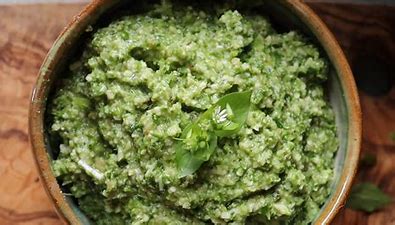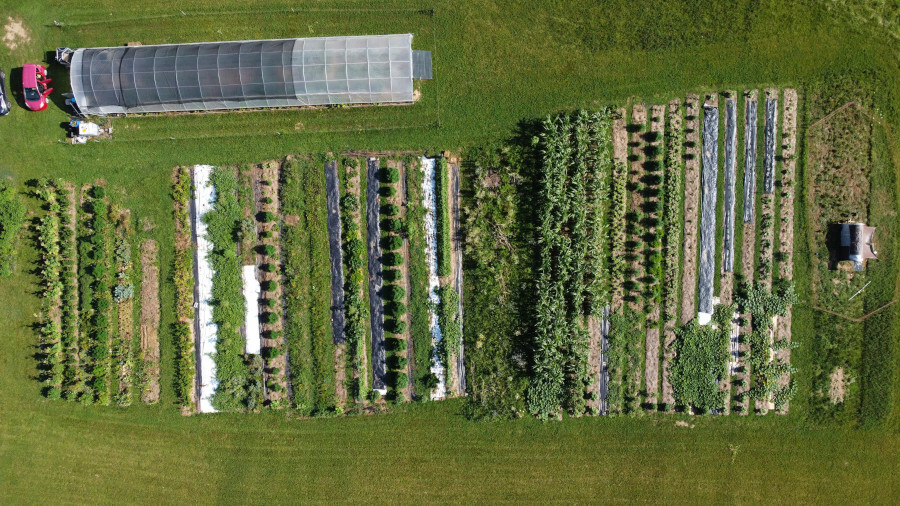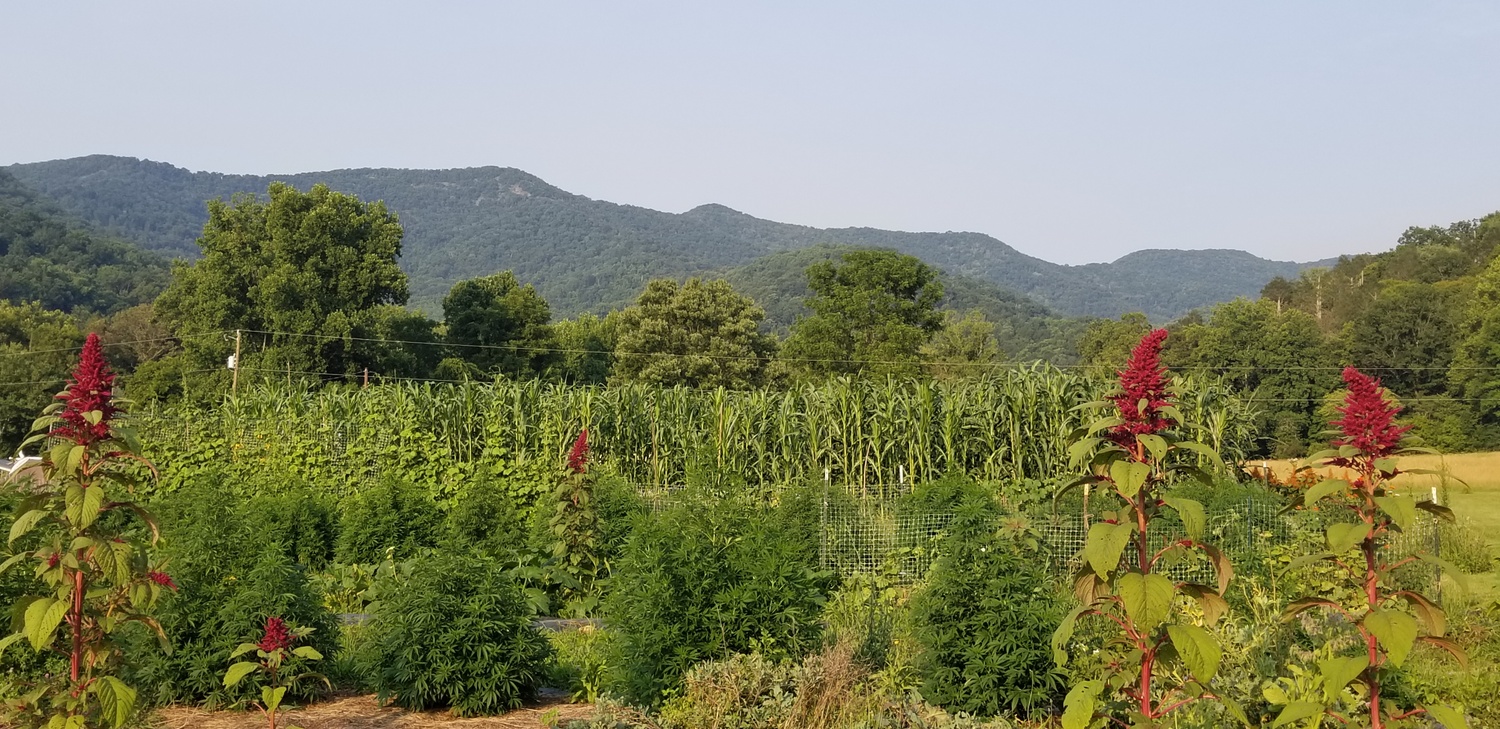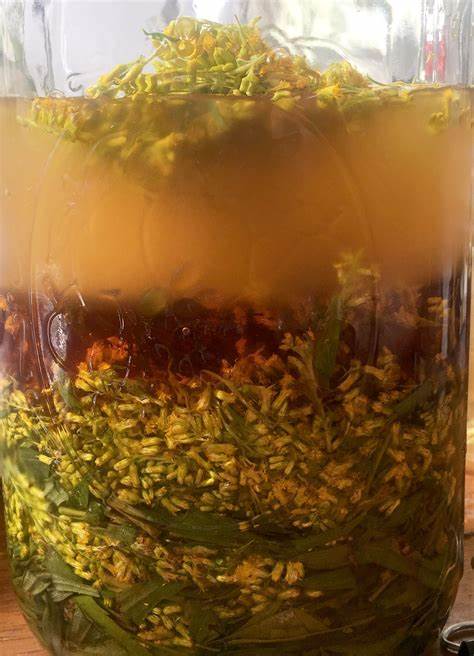


When we observe nature and in particular, forest ecology, we see a habitat with immense fertility and an abundance of biomass. The biomass of even just one large Oak or Redwood tree is incredible, and yet, no one has been carting fertilizer to it or intervening in any way for it to reach its massive size. It seems that the more mature a forest becomes and the larger its fauna grows, the more fertility the land itself creates. There is a magic that happens when plants, animals, bacteria, fungi and microbes are all working in unison. This synergy of microbes, fungus (such as Mycorrhizal), and beneficial organisms, all which thrive in environments rich with decomposing biomass, is what we strive to emulate using Sheet-Mulch style gardening.
Although we may not be able to generate the abundant biomass of the forest, which it achieves through unique microbiomes established over hundreds or thousands of years, we can do our best to follow its principals in our own gardens. When we observe how the forest functions, we can strive to emulate it though following a few principals such as: top-down composting/mulching, keeping the soil covered as much as possible with mulch or plants, and disturbing the soil as little as possible. We can emulate the wisdom of the forest through observing the rich life lessons it provides to us. In time, we can indeed create an garden sanctuary of annual and perennial plants that will become more fertile and abundant as the years go by.
Although plowing with animals has been practiced by humans for thousands of years, Industrial style, mechanized agriculture, involving heavy soil manipulation (Such as deep plowing, disking and heavy tilling) was introduced in the last century as a solution for feeding the world, however, its long term effects are just now becoming increasingly more clear. In the Mid-West of the USA alone, nearly 100 million acres of farmland have already lost their rich topsoil due to erosion. At the current rate of soil loss, some reports estimate the degradation of 90% of the Earth’s topsoil by 2050!
As you can see from the list above, the cost of feeding humanity utilizing these industrial scale methods is taking a great toll on the fertility and ability of the earth to sustain life. Industrial agriculture’s heavy dependence on synthetic fertilizers that run-off into rivers and oceans creating dead zones and their systematic use of pesticides and herbicides, known to cause cancer, are literally a deadly combination for the environment and humanity. This, along with the fact that nutrient deficient soils grow nutrient deficient food, should be motivation for everyone who has the time and desire to again tend to smaller scale gardens rich in life and ecologically abundant. The health of the soil and future generations depends on it.
Although these larger-scale, systematic problems can seem daunting, practicing Sheet-Mulch style, No-Till gardening on a smaller scale can have enormous positive impacts to both the land where it is practiced and the collective condition of our soils. Anywhere bare soil is present, soil can be washed away easily, making Sheet-Mulched beds an integral part of preserving precious topsoil. Imagine if 100s of millions of people began to practice these methods on a small to Mid-scale! Preserving and building our topsoil must be one of the greatest priorities for humanity, or we surely will not be able to sustain ourselves in the coming decades.
On a practical level, sheet-mulch style gardening has a myriad of benefits. One of the greatest benefits is the conservation of water. Mulched garden beds will “catch” rain in the beds themselves and keep it from “running off.” The mulch will preserve the precious moisture in your garden and also keep it from being lost due to evaporation (Once, we received 6 inches of rain in 48 hours and then no rain for 6 weeks. The Maize (Corn) we planted in well mulched beds continued to grow more than 4 feet in height during this 6 week drought and even after 6 weeks with no rain, I could reach my hand a few inches under the edge of the mulch layer and find lots of moisture!).
This type of drought protection will be necessary in the coming years as the climate continues to become more volatile. On a smaller, home garden scale, this means less need for irrigating, preserving precious water reserves, while creating more time for planting, tending, and food or herb processing.
Bare soil in the garden is a nursery for competitor plants or invasive weeds, and will always require tending to. Although working in Sheet-Mulch style beds will still require some weeding, generally, if managed well, the amount and intensity of weeding is reduced by up to 90%. Many of my well established beds only require small amounts of hand-weeding at the base of transplants where I have made planting holes. The surrounding, heavily mulched bed, does not allow seeds to germinate, eliminating most of the need for weeding. Less weeding means more time for planting, designing, and tending to your garden in other more useful ways.
Over time, Sheet-Mulched beds become more and more fertile, exhibiting some of the same beneficial elements the forest does. Through not disturbing the soil, all the beneficial fungus, bacteria, microbes and other beneficial critters remain intact and create the synergy plants need to thrive. The No-Till beds we have been tending for the past 7 years are much more fertile and easier to plant into with each passing year. After so many years of being maintained in this way, we seldom need to add more compost or manure to our beds (and generally only incorporate a little in our planting holes). We now maintain these beds by adding a nice layer of localized chop and drop comfrey during Autumn clean-up, which grows within 3 feet of the beds, and then follow up by top dressing the beds with a few inches to one foot of mulch hay. In the Spring, if the beds looks like they need it, we will add another layer of mulch hay a few inches thick. Building fertility from the “top down,” as the forest shows us, has proven to be less work with excellent results over time.
Sheet-Mulch style gardening allows you to transition your resources to other places. Because there is no need for a tiller or large machinery on a smaller scale, you can focus your resources on gathering other beneficial gardening tools. For example, instead of investing in a tiller, you could purchase a good quality wood chipper and transform debris from your property or neighborhood into free, readily available, material for mulching. Through implementing this type of gardening system, you can also help conserve fossil fuel resources in the long run.

I am a Plant Extrovert, Farmer, Herbalist, Teacher, Wild Wombyn, Mother and Daughter.





